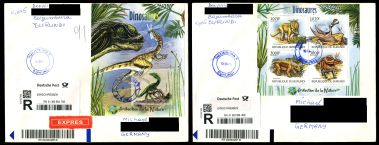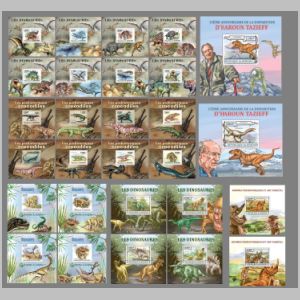the place where Paleontology and Paleoanthropology meets Philately
Burundi
Dinosaurs, other prehistoric animals and humans on stamps of Burundi
| << previous country | back to index | next country >> |
Contents
- Country overview
- Philately of Burundi
- Official stamps of Burundi related to Paleontology
- References
- Acknowledgements
Burundi, officially the Republic of Burundi, is a landlocked country in the African Great Lakes region of East Africa, bordered by Rwanda to the north, Tanzania to the east and south, and the Democratic Republic of the Congo to the west.
It is considered part of Central Africa. Burundi's capital is Bujumbura. The southwestern border is adjacent to Lake Tanganyika.
At the beginning of the twentieth century, Germany colonized this region. After the First World War and Germany's defeat, it ceded the territory to Belgium. The Belgians ruled Burundi and Rwanda as a European colony known as Ruanda-Urundi.
Burundi gained independence in 1962 and initially had a monarchy, but a series of assassinations, coups, and a general climate of regional instability culminated in the establishment of a republic and one-party state in 1966. Bouts of ethnic cleansing and ultimately two civil wars and genocides during the 1970s and again in the 1990s left the country undeveloped and its population as one of the world's poorest. In addition to poverty, Burundians often have to deal with corruption, weak infrastructure, poor access to health and education services, and hunger. [R1]

 Burundi has issued postage stamps for national use since
achieving independence on 1 July 1962.
For the first issue after independence, Burundi overprinted stamps of Ruanda-Urundi with Royaume du Burundi.
Subsequent stamps were inscribed "Royaume du Burundi".
In 1966, following political turmoil, Burundi became a republic and from then the stamps were marked
République du Burundi.
[R2]
Burundi has issued postage stamps for national use since
achieving independence on 1 July 1962.
For the first issue after independence, Burundi overprinted stamps of Ruanda-Urundi with Royaume du Burundi.
Subsequent stamps were inscribed "Royaume du Burundi".
In 1966, following political turmoil, Burundi became a republic and from then the stamps were marked
République du Burundi.
[R2]
In 2011-2013 Burundi was a client of Stamperija who start produce many colorful stamps for this country on every popular topic. For example, in 2012 Stamperija issued over 260 Blocks and Mini-Sheets with over 1300 (!) stamps in total. Just for comparison, Germany issue about 60 stamps per year.
However, many of these stamps were sent to the county and could be purchased in the local post offices and used for postage.
Official stamps of Burundi related to Paleontology: dinosaurs and other prehistoric animals and humans
| 31.08.2012 "Dinosaurs" | ||
 |
 |
 |
| 2016 "Extra print" [2] | 09.11.20232023 "Reprints: Dinosaurs" [3] | |
 |
 |
|
Notes:
[1] Haroun Tazieff (1914-1998) was a French volcanologist and geologist. He was a famous cinematographer of volcanic eruptions and lava flows, and the author of several books about volcanoes, but had nothing to do with dinosaurs or other prehistoric life.[R3]
[2] In the middle of 2016 Stamperija came with "Special offer of various BURUNDI delux", these Deluxe-Sheets shows the same designs as Burundi's stamps issued between 2011 and 2013, includes dinosaurs and other prehistoric animals, when the country was a client of the company.

These are likely illegal and probably not recognized by Burundi’s Post.
[3] According to Stamperija, since 2021 Burundi became their client again. In 2023, Stamperija produced many stamps for Burundi, including reprints of stamps issued in 2012 and 2013. They used the same, but other face values.
References:
- [R1] Burundi: Wikipedia, WikiTravel, FlagCounter.
- [R2] Postal History and Philately of Bolivia:
Wikipedia,
Links to official website of the Post Authority, stamp catalog and a list of new stamps of Burundi are here. - [R3] Haroun Tazieff: Wikipedia
Acknowledgements:
Many thanks to Dr. Peter Voice from Department of Geological and Environmental Sciences, Western Michigan University, for reviewing the draft page and his very valuable comments.
| << previous country | back to index | next country >> |